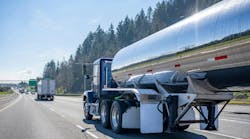WHEN Air Force One lands at George Bush Intercontinental Airport (IAH) in Houston, Texas, it is a virtual certainty that the distinctive blue and white 747 airliner will be refueled by Allied Aviation Services Inc. The company handles most of the aircraft refueling at IAH.
Aircraft refueling is a demanding operation even when it doesn't involve the airplane carrying the President of the United States. Refueling services continue 24/7, 365 days a year under a wide range of weather conditions. It's a tough job that takes rugged, application-specified, and well-maintained equipment.
“We take pride in delivering quality fuel to our airline customers, and we work hard to go beyond their expectations,” says Steve Minter, Allied Aviation maintenance manager at IAH. “We spec good fueling equipment that meets the demands of the job, and we keep the vehicles and other hardware in top shape with an aggressive maintenance program.
“Our performance is measured on timeliness, quality, safety, accuracy, and professionalism. When you're responsible for a fueling system that handles more than 1.5 million gallons of jet fuel a day, there is immense pressure on both the personnel in charge of delivering it and the equipment that is used to complete the process to get the job done correctly and safely.”
Shining light
The IAH fueling operation is one of the shining lights in the system built by New York, New York-based Allied Aviation, reportedly the largest domestically owned provider of fueling services to the commercial aviation industry in the United States. The company is the designated into-place service provider and/or fuel storage facility operator at 24 major airports in North and Central America.
In that role, the company manages the receipt, storage, and delivery of jet fuel used in the operations of airport fuel distribution systems with throughput in excess of six billion total gallons of Jet A every year. This means Allied Aviation plays a role in fueling approximately 1.6 million commercial flights annually.
Allied Aviation has been a long-time partner at IAH, which commenced operations in 1969. The airport has grown from its two original terminals to a total of five in order to meet increased domestic demand, as well as international traffic to and from destinations in South and Central America, Europe, and the Far East.
That demand equates to a daily fuel throughput that peaks at around 1.6 million gallons a day during the summer months. In all, Allied Aviation helps fuel 97% of the aircraft that depart IAH on a yearly basis. On more than one occasion, the flying traffic through the airport has included Air Force One.
With its 55 years of expertise in fuel handling, Allied Aviation played an important role during IAH's many years of expansion. The commitment to the growth of IAH was rewarded in 2007 when Allied Aviation received the prestigious Silver Nozzle Award for Organizational Excellence from the National Petroleum Management Association.
Next Page: Tough job
The fueling services provider helped design an extensive underground hydrant system that supplies jet fuel to all of the terminals. The company also assisted in building new fuel storage tanks at the airport that increased total storage capacity by 200%. Today, the company manages an airport tank farm with a 13-million-gallon total capacity.
In addition to the tank farm, Allied Aviation's operation at IAH includes a large and diverse fleet of vehicles that provide refueling services throughout the airport. The fleet is overseen by Minter, Allied Aviation's maintenance manager at IAH for the past nine years and a member of the maintenance crew for 10 years prior to that.
Allied Aviation's fleet mix at IAH includes refuelers with capacities ranging from 3,000 to 10,000 gallons, hydrant sump trucks that hold 800 to 1,500 gallons, and hydrant trucks and carts with pump rates from 300 to 750 gallons per minute. Primary vehicle suppliers are Garsite and Bosserman Aviation Equipment Inc.
The newest refuelers have non-code aluminum cargo tanks, Gorman Rupp pumps, a substantial jet fuel filtration system, LC Meter registers and meters, and reel-mounted Goodyear delivery hoses with Whittaker dry-break nozzles. Cabover trucks predominate and have 175- to 235-horsepower engines and automatic transmissions. All of the vehicles have brake interlocks that are actuated during aircraft refueling.
Tough job
All of the equipment gets a tough workout virtually every day. Allied Aviation handles 800 to 850 flights a day at IAH, which occupies about 10,000 acres. Each airplane that is refueled at IAH takes anywhere from a couple hundred gallons to 30,000 gallons of jet fuel. On average, it takes an hour to refuel each airliner.
Trucks endure a lot of driving miles and many engine hours of pump operation during the fueling process. “We put a lot of miles and wear-and-tear on our vehicles,” Minter says. “We see a lot of drivetrain, engine, and tire wear.”
Vehicle maintenance is handled in-house. Monthly preventive maintenance includes a detailed inspection. Lubricants and other fluids are checked and are replaced at scheduled intervals. Cargo tanks and fuel delivery systems last through several chassis replacements, which occur at approximately 10-year intervals.
Minter's maintenance responsibilities include supervision of the airport's sprawling in-ground jet fuel distribution capability that includes filtration, piping, and hydrant system. “Keeping water out of the fuel is a critical concern,” Minter says. “Fueling coming into our tank farm goes through several filter/water separation units, and it goes through more filtration at the point of delivery to the airplane.”
Hydrant service
As a member of the maintenance crew, Minter got plenty of experience with the hydrant system that moves jet fuel from the tank farm to the terminals and gates where the airplanes are parked. Once a month, Minter would help service the hydrant system, which has 134 low-point, 46 high-point and 56 service-point locations, and 10 tanks and two pump pads.
In order to do this, the pressure in the hydrant system would have to be brought down to a workable point and an assortment of adaptors of varying sizes and types would be used to drain the hydrant points of any water that could potentially contaminate the jet fuel. Sump trucks with vacuum tanks ranging from 800 to 1,500 gallons are used to clear the oily wastes liquids from the hydrant sumps.
While the system was able to meet the needs of IAH, it was full of any number of inefficiencies that would increase the chance of operator injury or fuel spills, which would have deleterious effects on both the bottom line and the environment. “We didn't have any dry breaks,” Minter says. “We just had connections onto a butterfly valve where the pressure would be built up to around 150 to 180 psi. If the valve wouldn't hold when the connections were unhooked, you'd have to shut the whole system down, or otherwise you'd have an overflow. Sometimes, because of the pressure, the caps would pop off and almost hit the operators' heads. There were incidents where people got hurt, where there were fuel spills, and we just couldn't depend on the standard quick connects that we were using at that kind of pressure.”
Minter says he knew there had to be a better and safer way to do the job. When he became maintenance manager, he turned to Ray Lingo of Raco Industrial Products (an OPW Engineered Systems representative) in Houston for some suggestions. Lingo recommended OPW's Kamvalok Dry Disconnect System.
“Ray introduced me to Kamvalok and it's the best thing since sliced bread,” Minter says. “These fittings are absolutely working like we expected them to.”
Next Page: Dry disconnect
Dry disconnect
Kamvalok meets the needs of Allied Aviation and its operations at IAH because they are designed with a unique poppet action that virtually eliminates spillage of any residual liquid that remains in the line after disconnection. They have been designed to shut off in the event of an accidental disconnection of the coupler and adaptor.
In other words, should the Kamvalok be disconnected due to operator error or accident while the lever is in the open position and product flow is in progress, the poppets in the adaptor and coupler will automatically close and immediately stop fuel flow through the coupler and adapter.
“We wanted to make it safer for the operator and the environment,” Minter says. “Since we converted to the Kamvaloks we can do maintenance any time we need to. We no longer have to shut the system down and we see less wasted fuel from spills during the hydrant service process.”
With a fueling hydrant system as complex as the one at IAH, a number of different technologies and equipment sizes originally were being used to service the system. Therefore, it took more than a year to convert and standardize the entire system — with its more than 200 service points — to the two-inch Kamvaloks. That upgrade was completed in 2007, which is — not coincidentally — also the year that Allied Aviation won the Silver Nozzle Award.
“It definitely was a big task to get the Kamvaloks into the existing system since we needed so many of them and we had to replace a variety of old equipment and valves,” Minter says. “However, it was definitely worth the wait. When you have one big spill and realize the cost in cleanup and lost fuel, you can appreciate the cost savings with the Kamvalok system.”








